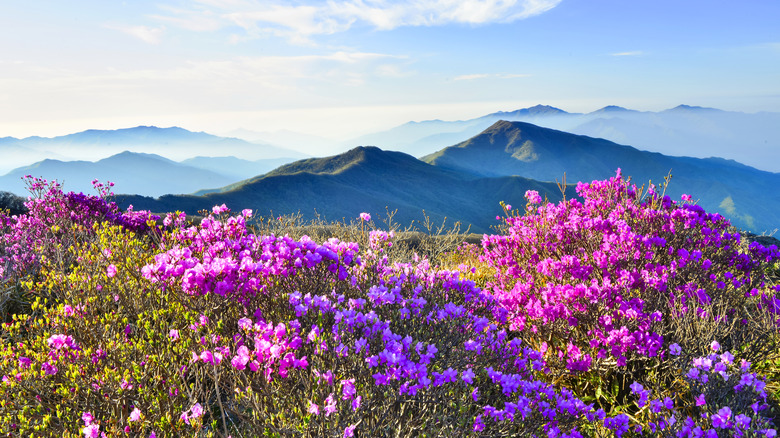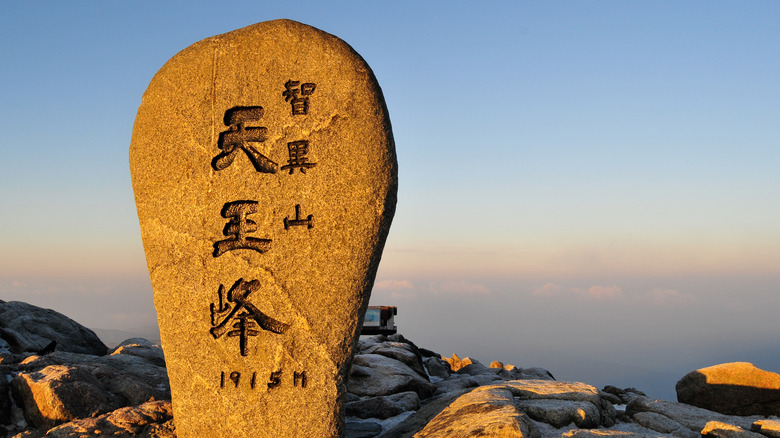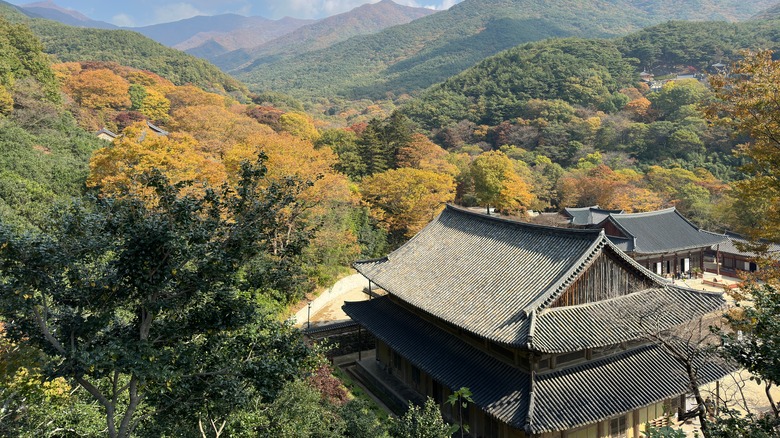The Highest Peak In Mainland South Korea Is A Wildlife Sanctuary With Temples And Stunning Views
Large and vibrant Seoul catches international attention with its Michelin-starred restaurants, fun nightlife, and flashy neon lights. The South Korean capital largely dominates what foreigners imagine when they think of the country. In fact, since there's so much to do here, many visitors never even leave the city, ignoring the gorgeous natural wonders that hide within the peninsula. If you're the kind of traveler who seeks adventures in the outdoors and wants a break from urban noise, plan to visit Jirisan National Park, South Korea's first and largest national park.
Established in 1967, the protected area has numerous trails and is one of the few places left in the nation where moon bears reside. Don't worry, though! These endangered animals — also known as Asiatic black bears — tend to keep to themselves. If you stick to marked trails, you likely won't encounter one. The park's main appeal is its eponymous landmark, Jirisan ("san" means "mountain" in Korean), which is the tallest mountain on the mainland and the second-tallest overall in the country.
Located in the wildly underrated southwestern part of South Korea, Jirisan is an oasis of tranquility and stunning natural beauty. It's considered one of South Korea's most sacred mountains because it houses numerous Buddhist temples, including Beopgyesa, the country's highest-elevation temple. Several trails take you up the mountain and connect to other summits within the park. While they are all worth hiking, almost all first-time visitors make the journey here to conquer Cheonwangbong, Jirisan's highest peak.
Hiking up Cheonwangbong
Rising 6,283 feet, Cheonwangbong offers some of South Korea's best scenery to those willing to work for it. The trail is steep and fairly demanding. It's largely made up of uneven, rocky terrain, so you'll want good-quality hiking boots. As you reach the top, there is a series of wooden staircases that provide relief for your feet but will definitely make your heart rate climb. Even these strenuous conditions won't make you regret coming here. Your journey to the top will be filled with breathtaking views of the national park, waterfalls, and ornate mountain temples. Once at the peak, you'll stand above the clouds and witness a side of Korea that few foreigners get to see.
One of the most popular routes to this peak is the Jungsanri-Cheonwangbong loop trail, which covers 7.1 miles. While this doesn't seem like too much, the steepness of the hike means that, on average, people take between eight and 12 hours to complete it. It's best to start the route early in the morning so that you can enjoy the great view from the peak without rushing to get back down. The way back to the trailhead is rough on the knees, but equally beautiful. If you start early, you can take your time on this section and make strategic rest stops to appreciate your surroundings. Right outside the end of the trail, you'll find a Korean restaurant serving delicious food and drinks where you can celebrate your achievement.
Visiting Jirisan National Park
Foreigners usually arrive in South Korea via Incheon International Airport, named the world's most comfortable airport, which is near Seoul. From the capital, you can take a bus to Guyre and then another one to the park. Since you'll arrive in the small town in the early afternoon, you'll want to sleep here and do the hike the next morning. Or, even better, start part of the hike on the day that you arrive and then spend the night in a shelter within Jirisan. There are two shelters near Cheonwangbong: Rotary and Jangteomok. Both are fairly basic but comfortable and provide the wonderful opportunity to sleep within the national park and break up the hike in two days rather than one. If you choose this route, pack food or check if your chosen shelter sells basic meals like instant ramen packets. Make sure to also bring a water bottle with a built-in filter. This will make it easier to refill your bottle at the shelters and waterfalls on the way to the peak.
Another option is to join a guided tour. This is a good choice if you prioritize comfort or if you're worried about navigating the bus system in non-touristy areas without speaking Korean. Tours normally include transportation, food, and a guide. If the hike up Jirisan makes you excited for an even bigger challenge, head to Jeju Island, often called the Hawaii of Korea. Here, you'll find the majestic Hallasan, South Korea's tallest mountain.


